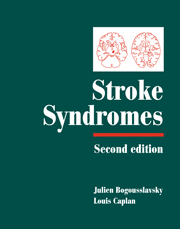Book contents
- Frontmatter
- Contents
- List of contributors
- Preface
- PART I CLINICAL MANIFESTATIONS
- PART II VASCULAR TOPOGRAPHIC SYNDROMES
- 29 Arterial territories of human brain
- 30 Superficial middle cerebral artery syndromes
- 31 Lenticulostriate arteries
- 32 Anterior cerebral artery
- 33 Anterior choroidal artery territory infarcts
- 34 Thalamic infarcts and hemorrhages
- 35 Caudate infarcts and hemorrhages
- 36 Posterior cerebral artery
- 37 Large and panhemispheric infarcts
- 38 Multiple, multilevel and bihemispheric infarcts
- 39 Midbrain infarcts
- 40 Pontine infarcts and hemorrhages
- 41 Medullary infarcts and hemorrhages
- 42 Cerebellar stroke syndromes
- 43 Extended infarcts in the posterior circulation (brainstem/cerebellum)
- 44 Border zone infarcts
- 45 Classical lacunar syndromes
- 46 Putaminal hemorrhages
- 47 Lobar hemorrhages
- 48 Intraventricular hemorrhages
- 49 Subarachnoid hemorrhage syndromes
- 50 Brain venous thrombosis syndromes
- 51 Carotid occlusion syndromes
- 52 Cervical artery dissection syndromes
- 53 Syndromes related to large artery thromboembolism within the vertebrobasilar system
- 54 Spinal stroke syndromes
- Index
- Plate section
44 - Border zone infarcts
from PART II - VASCULAR TOPOGRAPHIC SYNDROMES
Published online by Cambridge University Press: 17 May 2010
- Frontmatter
- Contents
- List of contributors
- Preface
- PART I CLINICAL MANIFESTATIONS
- PART II VASCULAR TOPOGRAPHIC SYNDROMES
- 29 Arterial territories of human brain
- 30 Superficial middle cerebral artery syndromes
- 31 Lenticulostriate arteries
- 32 Anterior cerebral artery
- 33 Anterior choroidal artery territory infarcts
- 34 Thalamic infarcts and hemorrhages
- 35 Caudate infarcts and hemorrhages
- 36 Posterior cerebral artery
- 37 Large and panhemispheric infarcts
- 38 Multiple, multilevel and bihemispheric infarcts
- 39 Midbrain infarcts
- 40 Pontine infarcts and hemorrhages
- 41 Medullary infarcts and hemorrhages
- 42 Cerebellar stroke syndromes
- 43 Extended infarcts in the posterior circulation (brainstem/cerebellum)
- 44 Border zone infarcts
- 45 Classical lacunar syndromes
- 46 Putaminal hemorrhages
- 47 Lobar hemorrhages
- 48 Intraventricular hemorrhages
- 49 Subarachnoid hemorrhage syndromes
- 50 Brain venous thrombosis syndromes
- 51 Carotid occlusion syndromes
- 52 Cervical artery dissection syndromes
- 53 Syndromes related to large artery thromboembolism within the vertebrobasilar system
- 54 Spinal stroke syndromes
- Index
- Plate section
Summary
Historical background and terminology
Low-flow infarctions, also called ‘border zone infarctions’, are the result of a critically reduced cerebral perfusion pressure in far-downstream brain arteries that leads to a critically reduced cerebral blood flow and oxygen supply in certain vulnerable brain areas. These areas are defined by the specific angioarchitecture of the cerebrum. The term watershed infarction should be reserved for the cortical infarcts located in-between the territories of the major cerebral arteries, and should not be extended to the more common, subcortical type of low-flow infarction. The latter is located within the affected vascular distribution but in a zone of marginal irrigation (i.e. border zone) comparable to the ‘last field’ in a unidirectional (i.e. non-collateralized) agricultural watering system (Zülch & Behrend, 1961). The more general terms ‘low-flow infarction’, or ‘hemodynamically induced infarction’, are preferred, whereas terms like ‘deep watershed territory’-infarct (Angeloni et al., 1990) or ‘internal border zone territory’-infarct ((Angeloni et al., 1990) or ‘internal watershed infarctions’ (Bladin & Chambers, 1993) are misleading.
In a wider sense, all ischemic brain infarcts are the consequence of a critically reduced blood flow. The concept underlying low-flow infarctions, however, emphasizes a difference between them and thromboembolically caused infarcts. In the thromboembolically induced brain infarcts, the corresponding cerebral artery(ies) is(are) occluded (rarely stenosed) by embolisms of various origins or by in situ atherothrombosis. By contrast, in low-flow infarctions the local brain artery(ies) supplying the infarcted area is(are) not diseased.
- Type
- Chapter
- Information
- Stroke Syndromes , pp. 564 - 582Publisher: Cambridge University PressPrint publication year: 2001
- 13
- Cited by



